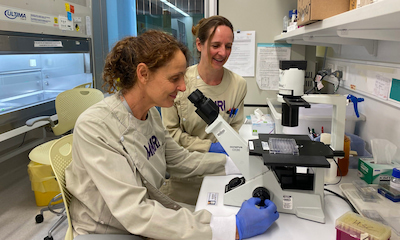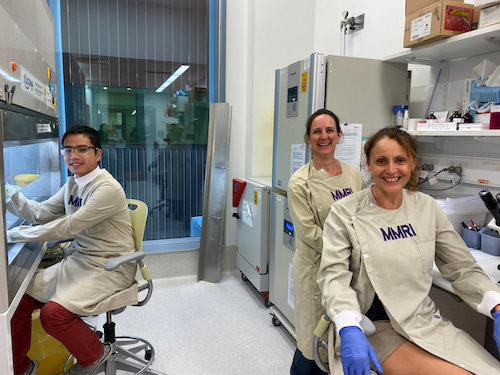Adding the microenvironment to the AML therapy mix improves efficacy
For many years, Associate Professor Ingrid Winkler has worked on a new area of research to improve treatment efficacy, and her discoveries have “opened up a whole new field”.
This is based on the body organs’ microenvironments (niches) and how they can regulate our cells by protecting and nurturing them.

The senior research fellow at the Mater Research Institute – University of Queensland is driven by a passion for understanding how the body works, and in discussing her work, she frequently refers to a ‘seed and soil’ analogy.
“If you’re studying a seed, it’s really important to look at the soil it’s living in, and all of a sudden, it’s ‘oh wow’, and out comes an important clinical trial!” she said.
A/Prof Winkler’s laboratory findings supported an international multi-centre, multi-arm Phase I/II trial by the U.S. biotech company, GlycoMimetics, testing a new drug, uproleselan (also known as GMI-1271), for relapsed and refractory AML.
One of the trial sites was in Australia, at the Princess Alexandra Hospital, near A/Prof Winkler’s laboratory in Brisbane. Later, the trial was extended and eligibility was expanded to include patients with newly diagnosed, previously untreated AML, as well as those with relapsed/refractory disease.
Results of the Phase I/II clinical trial led to uproleselan being granted breakthrough therapy status by the FDA in the U.S. in 2017, and in 2018, the Phase III* trial opened with six sites** in Australia, including at Princess Alexandra Hospital, Brisbane.
This Phase I/II clinical trial tested the addition of uproleselan to a standard chemotherapy regimen (cytarabine/daunorubicin) in older patients with relapsed or refractory AML.
Although primarily conducted to determine safety, the relapsed/refractory AML patients on the trial experienced higher rates of remission than would historically be expected and reduced treatment-related side-effects.
When this small Phase I/II trial was extended to newly diagnosed older AML patients, the addition of uproleselan to the standard chemotherapy regimen appeared to further increase rates of remission compared to historical expectation and potentially also reduced events, something A/Prof. Winkler also observed in her preclinical laboratory studies and which is the subject of ongoing research in Queensland.

Background to this new field of research
A/Prof. Winkler’s interest is “the body’s stem cells and how they are regulated by the places where they are living”. The particular stem cell she works on are haematopoietic stem cells (HSCs) which live in the bone marrow and make the blood and immune system.
“HSCs have two roles. One is to be active, that is make new the blood in the immune cells if needed, and the other is that a proportion of them stay asleep,” said A/Prof Winkler.
“These sleeping HSCs are what we call dormant and are your long-term back-ups. These are the ones that will get you into old age, and they are the stem cells that we want to transplant.
“And that’s where a molecule called E-selectin comes in. E-selectin is made by blood vessels after injury or stress. It plays an important part in bone marrow regulation, waking up HSCs when needed to respond to that stress.”
A/Prof. Winkler started looking at malignant cells in pre-clinical laboratory models (to replicate what happens in people) and found the leukaemias themselves were making E-selectin levels go up, and began to ask why.
“I studied AML, partly because the prognosis is so poor. For me, I consider AML happens when the stem cells I study turn bad.
“Surprisingly, this molecule appears to have a completely different role in malignant cells like AML, it actually promoted the survival of the malignant cells; it has two roles. When we blocked it using the drug uproleselan (GMI-1271) in laboratory models, the leukaemia cells became more sensitive to the therapy.
“It sounds too good to be true and I have done a lot of work trying to understand this process – why the same molecule has the opposite effect on those two cell types (normal vs malignant).
“I think I understand it now, finally, and the fact is, it does,” said A/Prof. Winkler.
Her findings, recently published in Nature Communications, shows that blocking the interaction between leukaemia cells and their environment in the bone marrow (niche), at the same time as chemotherapy is administered, enables the chemotherapy to work more effectively in laboratory models.
A/Prof. Winkler’s findings describe how the same molecule affects normal HSCs differently from AML cells.
“This has a lot to do with the ‘abnormal degree of biological sugars’ on the surface of the AML cells, which helps them interact and receive signals from their environment in a different way,” she explained.
“These abnormal sugars mean the AML cells receive a survival signal from (E-selectin in) their environment that normal cells do not.
“Our laboratory models show that blocking this sugar interaction stops this ‘survival signal’ and sensitises the AML cells to cancer therapy.
“And if you administer uproleselan, which blocks E-selectin during therapy, you may be protecting the HSCs but sensitising the leukaemia cells to therapy.
“Given alone, this drug has no effect, but given with chemotherapy, it improves the outcome of leukaemia treatment better in our laboratory studies and there is less mortality.
“It’s really about how the leukaemia cells hijack these nice little environments that are actually designed for stem cells,” said A/Prof. Winkler.
“Leukaemia stem cells have intrinsic ways of resisting therapies; they are able to pump out the therapies and this is one of the ways they resist treatment.
“Everyone [researchers] has been focusing on these properties, to get rid of them.
“They are all missing the whole other side of the story; that there are all these places, where the leukaemia cells live in the bone marrow, that also protect them,” said A/Prof. Winkler.
Back to the “seed and soil thing”, she said, “nobody had really looked at the soil around those cells”.
“This work is really the first example of where a molecule from the soil is blocked.
“And it’s safe to block because this molecule shouldn’t really be there much if you are healthy.”
A/Prof. Winkler said her pre-clinical laboratory models suggests up to 80% of resistance to chemotherapy may be mediated by the environment. Back to the seed in the soil again.
“You really want to target both the leukaemia cell itself, and its supportive environment,” said A/Prof. Winkler.
“I think, long-term, that is where the big story is.”
A/Prof. Winkler said treatments were needed that target both the leukaemia and its microenvironment, because “stopping how the leukaemia manipulates its environment to gain support is at least half of the story”.
“Ideally, we would do away with chemotherapy, but it is great at triggering changes in the whole system, and low doses of chemotherapy could be used to stop those protective environments from popping up again,” she said.
“I think that achieving what we already can now, but with lower doses, fewer side-effects and a much better quality of life, is where we would like to be, at least in the short-term.
“Your body can’t really cope with more than a few rounds of high dose chemotherapy. Children with haematopoietic malignancies can more tolerate the doses of chemotherapy needed to achieve cure, whereas adults can’t.
“I would like patients with relapsed/refractory AML, who were going into therapy, to be aware that this trial is underway in Australia,” said A/Prof. Winkler.
“Over the next five years, I hope to see the balance changing as we find ways to mix and match available therapies, targeting both the malignant cells and at same time removing their environmental support, to give patients the best overall outcomes,” said A/Prof. Winkler.
* https://clinicaltrials.gov/ct2/show/NCT03616470?term=GMI-1271+AML&draw=2&rank=1
** Calvary Mater Newcastle, Sir Charles Gairdner Hospital (Perth), Townsville Hospital, Princess Alexandra Hospital (Brisbane), Flinders Medical Centre (Adelaide), Cancer Clinical Trials Centre (Melbourne).
Last updated on July 7th, 2021
Developed by the Leukaemia Foundation in consultation with people living with a blood cancer, Leukaemia Foundation support staff, haematology nursing staff and/or Australian clinical haematologists. This content is provided for information purposes only and we urge you to always seek advice from a registered health care professional for diagnosis, treatment and answers to your medical questions, including the suitability of a particular therapy, service, product or treatment in your circumstances. The Leukaemia Foundation shall not bear any liability for any person relying on the materials contained on this website.